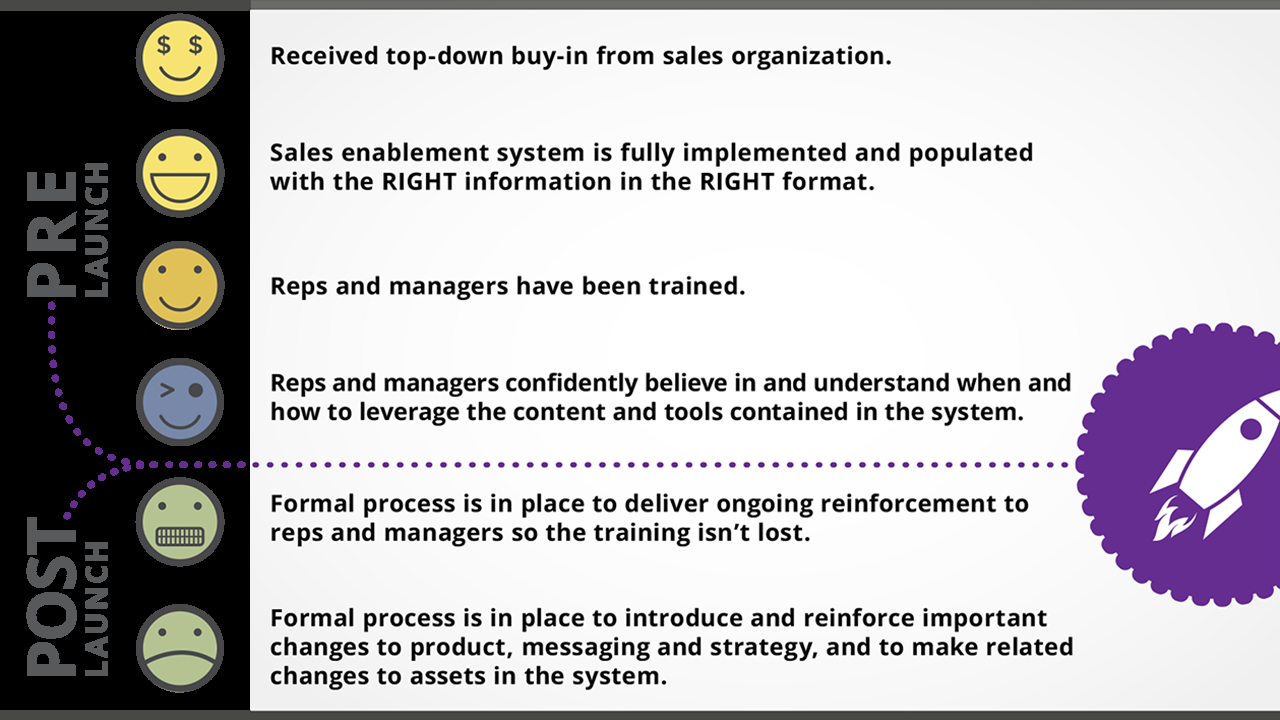
Is your sales enablement
system preventing sales?
system preventing sales?
First there were sales portals—in theory, a great idea for putting sales collateral and other selling tools in one easy-to-access repository. But no one used them. Sales enablement tools followed closely behind, with the compelling promise of an intelligent software platform that would bridge the marketing-sales divide once and for all. They would help salespeople up their performance through better content, consistent execution and better, more targeted message delivery. And, it’s true, sales enablement platforms can be powerful tools for turning leads into customers.
Look up sales enablement and you’ll find numerous definitions. Global market intelligence firm IDC defines it as “getting the right information into the hands of the right sellers at the right time and place, and in the right format, to move a sales opportunity forward.” An apt description, it assumes the right seller understands all the available content assets so they know how to best use them at the right time. In practice, this is rarely the case.
Here’s why:
- Sales enablement implementations, like most technology roll-outs, suffer from a project mentality. They focus too much on how to use the software and too little on applying the right content strategies in real-world sales situations.
- Reps are so overloaded with information during pre-launch training they forget most of it before they get a chance to apply it on a sales call.
- When the project ends, companies pop champagne corks, check the box, collect their MBOs and move on to their next priority. Then post-launch everything changes and there is no formal process in place to transfer these changes into practice.
- All of the above translates to low rep and manager confidence, leading to low adoption rates.
The disconnect between sales enablement software and the delivery of its promise is a common complaint among sales and marketing executives who advocated for the technology and made a significant investment by purchasing it, populating it and rolling it out to the sales force.
Need proof?
The failure of sales enablement continues to be a hot topic for marketing blogs and trade publications. One in particular drives the point home:
Alinean Founder Tom Pisello cites depressing statistics on why companies are not seeing a payoff on sales enablement in his “Return on Sales Enablement: The Adoption Challenge” blog post. Among them:
- What about all the investments over the past decade in CRM? Unfortunately, 40 percent of sales reps still fail to achieve quota each year, and new rep ramp-up still takes nine months or longer (CSO Insights).
- What about the millions spent on new methodologies and sales training each year? Eighty-seven percent is forgotten and abandoned within weeks (CEB). Worse, less than 10 percent of sales reps are identified by buyers as being focused on what matters to them most—value and outcomes—with 58 percent disengaging as a result (Forrester/Qvidian).
- And what about all that great content? Ninety percent of it never gets used by typical sales reps. Instead reps spend six hours per week recreating or customizing content (IDC).
He sums it up with a telling statement:
Whether it’s CRM, training or content, there seems to be a disconnect between today’s sales enablement investments and realized performance improvements. And most of it comes down to sales rep adoption or lack thereof.” Pisello recommends “implementing programs in concert to be sure your sales reps have the methods, tools and coaching to achieve success.”
Lost Opportunities
Project alignment: Salespeople must know how to use the software; they need to believe the WIIFM (What’s In It For Me?) factor; and most importantly they need to remember to actually use it at the moment of truth. Sure, this was explained to them in detail during a daylong meeting when the system was rolled out. There was great excitement over the shiny new toy and everyone was eager to put it to use and they did—for a while. Then the reps forgot about it and management realized their “Great Hope” had fallen into disuse. The
sales force was back to their old way of doing things.
New product launches: Knowledge retention is equally a problem with product roll-outs. Marketing spends months preparing wildly compelling sales collateral, videos, presentations, demos, case studies, market intelligence, buyer personas and more—everything salespeople could possibly need to do their jobs. They populate the sales enablement system and perhaps go a step further and create a sales playbook that clusters relevant content by buying cycle stages. Then, together with the sales executives, they introduce the product, collateral and tools to the sales teams in another daylong meeting. It’s a little like drinking from a fire hose. They’re able to swallow some of it, but most of it splashes away.
Change management: Of course, it generally isn’t too long after a new product roll-out that something changes. Maybe something changes with an older product, or a new pricing structure or sales promotion is announced. Perhaps a new market is revealed, a new success story is introduced or a new competitor threatens. These and many other types of changes affecting the sales force happen every month, sometimes even several times a month. These changes are typically communicated to the sales organization via email, which is, likewise, typically ignored. Salespeople are preprogrammed to ignore anything that doesn’t help them move the buying process along. That means they read email from their manager, customers and prospects. That’s it. Email—the preferred delivery vehicle for change announcements to salespeople—fails miserably.
Lack of follow-up: Other delivery options don’t fare too well, either. Whether software and product training is delivered via classroom, webinar or online course, most of what is learned is quickly forgotten. These methods are great introductory tools, but that’s where their influence ends. Or worse, as in the case of an email, the information is missed completely.
Typical Methods
Does this scenario seem familiar?

So what’s the missing link?
Simply put, what’s missing between a successful sales enablement implementation and a sale is a learning reinforcement strategy. Out of the project gate, learning reinforcement helps salespeople remember to leverage the right sales enablement assets in the heat of battle, during a sales call. It keeps them informed on important changes in product, messaging and strategy post-project. And finally, when a sales enablement “power adopter” creates new best practices, they can be shared with other sales teams to drive more confidence and consistency.
The solution is Q
q.MINDshare™ (“Q”) is a form of nudge-tech designed specifically to disrupt the forgetting curve associated with sales training. Q fills gaps in sales enablement to help reps remember when, how and why to use content to facilitate customer buying cycles. Q’s noise-free delivery system cuts through clutter to spoon-feed reinforcement to reps each week, and it measures what’s sticking and what’s not so identified risks can be coached proactively.
How Q works
Each week, Q pushes out an alert to all reps, letting them know they have something important to review. Reps click on the reminder to launch the review session, which only takes minutes to complete. During each session, reps review tips and answer interactive questions. If the rep responds incorrectly, he or she gets an instant explanation to learn more about the correct response. Q then adapts future review sessions to the needs of each rep, giving repeated views of that material until it is mastered.
Management reports track user / team progress, alignment gaps and knowledge improvement over time.
Project Alignment: With Q, reps confidently know how to use the sales enablement software and how best to leverage the right content at the right time to accelerate sales. Q replaces hope with a proven methodology that drives rapid and sustainable adoption.
Product Knowledge: Q continuously streams product reinforcement so reps talk confidently about products, use cases and success stories during sales calls. New product launches are quickly assimilated as well, accelerating go-to-market.
Change Management: Q delivers important changes in product, messaging and strategy and reinforces them with each rep and manager. Q reports and dashboards let you know your important changes were not only received, but also fully understood.
What’s the payoff?
Sales teams forget more than 50 percent of what they need to know to be prepared to speak to a prospect. Even worse, each rep has his or her own version of the knowledge they do retain, which translates to field message distortion and less predictable outcomes. Q improves learning retention and accuracy to over 90 percent, meaning your sales teams will consistently and confidently say and do the right things at the right time while on sales calls. With Q this is your new reality. Imagine your results now.
Giving your reps sales enablement software is like giving them free gym memberships. All the resources are there to make them successful, but that doesn’t mean they are going to work out frequently enough to make a difference. And even if they are working out, it doesn’t mean they are focusing on the right things. View Q as their personal trainer. Q assesses reps’ strengths and weaknesses every week, then focuses on the areas where they need the most help—all while letting their managers know their progress.
Rapid and easy implementation
- REPS: There is no rep training required at all when you activate Q (reps already know how to answer questions and read tips). There is no “software” for them to remember to access. Q comes to them, pushing an actionable reminder using Cut-Thru Technology that gets their attention 100 percent of the time.
- ADMIN STAFF: Q is designed for subject matter experts, so no technical skills are required. We spend our time with your administrative staff, transferring best practices so your reinforcement strategy is both successful and sustainable.
- TECHNOLOGY: Q is cloud-based so it is a very easy complement to any change initiative.

